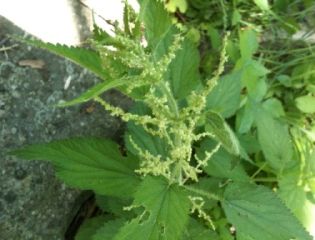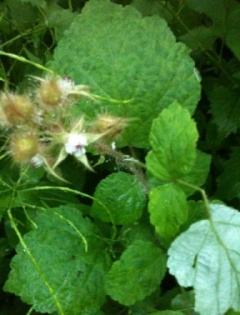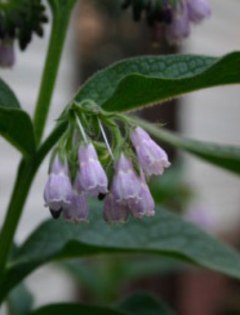| 
|
Nettle (Urtica dioica)
Uh-oh! Here’s nettle in flower. Too late now to harvest it for drying or eating. The only reactions reported from ingestion of nettle have occurred when the flowering plant has been consumed, so I stay away from it once flowers are visible. What can we do with flowering nettle? Wait; wait for the flowers to set seeds and for the seeds to ripen and then harvest the seeds. Or cut it and use it to make nettle rot fertilizer. Cover nettle stalks and leaves with cold water in a bucket, cover, and wait 3-6 weeks, or until it stinks. I use 1-3 cups of this diluted in a gallon of water to keep my gardens lush all summer. |
| 
|
Raspberry (Rubus species)
This photo is of a special local variety of raspberry that is incredibly delicious. Note that the back of the leaf is white. This is the easiest way to distinguish raspberry from blackberry; the color of the berries can be confusing, for there are red blackberries and black raspberries as well as black blackberries and red raspberries (and golden raspberries, too). As with the nettle, once the raspberry is flowering, I stop harvesting. Second-year canes bear fruit, so are not ideal for medicine, and the first year canes, which are the best for drying, need to gather energy now so they can fruit next year.
|
| 
|
Comfrey (Symphytum uplandica x)
Here are the beautiful flowers of garden comfrey, the one that is safe to use. Wild comfrey, which does not occur in North America, has yellow flowers and is a smaller plant. Henry Doubleday, an Englishman, hybridized "blue comfrey," also known as Siberian comfrey, to remove the problematic, liver-disturbing alkaloids found in the wild comfrey. I have drunk comfrey infusion (mostly from comfrey that I have purchased from herbal suppliers) for over thirty years with no ill effects. My sweetheart, who drinks twice as much comfrey infusion as I do, was declared very healthy on a recent liver function test. (Which was done as standard procedure, not because there seemed to be a problem). To harvest: I cut entire flowering stalks of garden comfrey near the ground and hang them individually to dry. The stalk is especially rich in alantoin, a healing alkaloid. |
